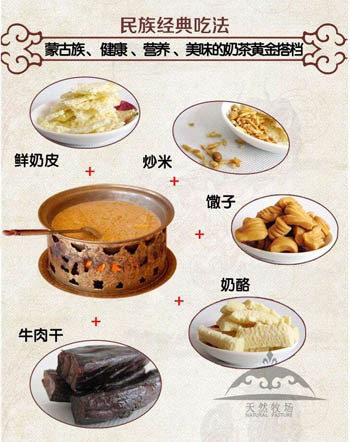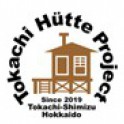2019年7月29日(月)
Mongolian milk tea
English×2

Mongolian milk tea, cooking & history
(A short note at Supohan Grassland, Ordos, Inner Mongolia, China, translated to English by Ms. L. Xue, July 16, 2019)
Mongolian milk tea, commonly known as "Sutai", is popular as a dairy product in Mongolian, which made from brick tea with a salty taste. It is a traditional diet, and also a major method of supplementing human nutrition, as well as addition to quenching thirst.
Cooking method: It made of green or black brick tea, and the cooking tool is an iron pot. For cooking, you should break the brick tea first, put the pot on the fire, hold 2~3 liters of water, burn until boiling, and then add 50~80 grams of broken brick tea. After boiling for another 5 minutes, add milk, use about 1/5 of the water, stir a little, and then add the appropriate amount of salt. When whole pot of the tea begins to boil, it is ready for serving.
History of development: In history, the brick tea has been favored by the Mongolian people. According to historical records, during the Kangxi era of the Qing Dynasty (around 1700), some merchants in the Mainland carried brick tea, rice noodles, cloth and other things to the hinterland of Mongolia to exchange local products. The rice noodles and cloth can exchange the animal fur directly, while the value of other things is determined by the brick tea, which was calibrated the value of items as currency. It is not uncommon for a brick tea to exchange a sheep. Since then, the custom of replacing the whole sheep with brick tea as gifts to relatives and friends has been created on the grasslands. The brick tea gradually lost its qualification to replace the currency and restore the original appearance as a drink.
Nutritional value: The tea contains tannins, amino acids, essential oils, caffeine and vitamin C, D, B and other rich nutrients. It has strong heart, diuretic, spleen, hematopoiesis, bone formation, refreshing and strengthening blood vessel walls. Such as medicinal functions, as well as the dissolution of fat, promote digestion and so on. Therefore, tea, especially brick tea, has gradually occupied an important position in the life of the Mongolian people. If you do not drink tea one day, you will feel anger, dizziness, poor appetite and hard to have a good sleep at night. Legend has it that during the period of Genghis Khan, the Mongolian soldiers did not need to bring more grain, and with brick tea, it would be equal to having grain.
Food culture: Drinking salty milk tea made from brick tea is a part of traditional Mongolian life and culture. In pastoral areas, people are used to say "three times of drinking tea and only a meal for one day." Every morning, the first thing of the housewife does is to cook a pot of salted milk tea for her family to enjoy whole day. In the morning, they drink tea while eating fried glutinous rice and the rest of the tea is warmed on a light fire so that it can be taken hot tea at any time. Usually, a family only grazes home at night to officially dine once, but it is generally indispensable to drink the milk tea three times, in the morning, the noon and the evening.
If they have a guest at home, the warm and hospitable hosts will first sip a fragrant milk tea to express a sincere welcome. If not serving the tea, it will be regarded as the rudest behavior on the grassland.
Above picture is downloaded from the Baidu website and includes some milk tea companions. It includes milk cover (keep the milk boiling for a long time, and this is the top layer when milk cooling down), fried glutinous rice, dry noodles (knead into dough with a small amount of water, then made into a certain shape, fried with sheep (goat) oil), cheese, dried beef.
(A short note at Supohan Grassland, Ordos, Inner Mongolia, China, translated to English by Ms. L. Xue, July 16, 2019)
Mongolian milk tea, commonly known as "Sutai", is popular as a dairy product in Mongolian, which made from brick tea with a salty taste. It is a traditional diet, and also a major method of supplementing human nutrition, as well as addition to quenching thirst.
Cooking method: It made of green or black brick tea, and the cooking tool is an iron pot. For cooking, you should break the brick tea first, put the pot on the fire, hold 2~3 liters of water, burn until boiling, and then add 50~80 grams of broken brick tea. After boiling for another 5 minutes, add milk, use about 1/5 of the water, stir a little, and then add the appropriate amount of salt. When whole pot of the tea begins to boil, it is ready for serving.
History of development: In history, the brick tea has been favored by the Mongolian people. According to historical records, during the Kangxi era of the Qing Dynasty (around 1700), some merchants in the Mainland carried brick tea, rice noodles, cloth and other things to the hinterland of Mongolia to exchange local products. The rice noodles and cloth can exchange the animal fur directly, while the value of other things is determined by the brick tea, which was calibrated the value of items as currency. It is not uncommon for a brick tea to exchange a sheep. Since then, the custom of replacing the whole sheep with brick tea as gifts to relatives and friends has been created on the grasslands. The brick tea gradually lost its qualification to replace the currency and restore the original appearance as a drink.
Nutritional value: The tea contains tannins, amino acids, essential oils, caffeine and vitamin C, D, B and other rich nutrients. It has strong heart, diuretic, spleen, hematopoiesis, bone formation, refreshing and strengthening blood vessel walls. Such as medicinal functions, as well as the dissolution of fat, promote digestion and so on. Therefore, tea, especially brick tea, has gradually occupied an important position in the life of the Mongolian people. If you do not drink tea one day, you will feel anger, dizziness, poor appetite and hard to have a good sleep at night. Legend has it that during the period of Genghis Khan, the Mongolian soldiers did not need to bring more grain, and with brick tea, it would be equal to having grain.
Food culture: Drinking salty milk tea made from brick tea is a part of traditional Mongolian life and culture. In pastoral areas, people are used to say "three times of drinking tea and only a meal for one day." Every morning, the first thing of the housewife does is to cook a pot of salted milk tea for her family to enjoy whole day. In the morning, they drink tea while eating fried glutinous rice and the rest of the tea is warmed on a light fire so that it can be taken hot tea at any time. Usually, a family only grazes home at night to officially dine once, but it is generally indispensable to drink the milk tea three times, in the morning, the noon and the evening.
If they have a guest at home, the warm and hospitable hosts will first sip a fragrant milk tea to express a sincere welcome. If not serving the tea, it will be regarded as the rudest behavior on the grassland.
Above picture is downloaded from the Baidu website and includes some milk tea companions. It includes milk cover (keep the milk boiling for a long time, and this is the top layer when milk cooling down), fried glutinous rice, dry noodles (knead into dough with a small amount of water, then made into a certain shape, fried with sheep (goat) oil), cheese, dried beef.
| コメント(0件) | コメント欄はユーザー登録者のみに公開されます |
コメント欄はユーザー登録者のみに公開されています
ユーザー登録すると?
- ユーザーさんをお気に入りに登録してマイページからチェックしたり、ブログが投稿された時にメールで通知を受けられます。
- 自分のコメントの次に追加でコメントが入った際に、メールで通知を受けることも出来ます。
